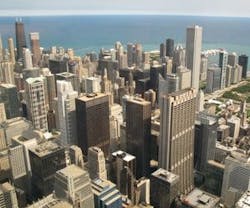City of Chicago Recognizes Ballasted EPDM as ‘Cool Roof’ Alternative
The City of Chicago has added ballasted roof systems as an accepted cool-roofing alternative in its municipal code. In the latest version of its code, Chicago is allowing for an exception in its listing for low-sloped roofs that reads as follows:
“Low-sloped roofs permitted on or after Jan. 1, 2009, in conjunction with a new building or structure, shall utilize roofing products that meet or exceed an initial reflectance value of 0.72 or a 3-year installed reflectance value of 0.5 as determined by the Cool Roof Rating Council or by ENERGY STAR.”
The exception reads as follows:
“Ballasted roofs with a minimum of 15 lbs/square feet of ballast over the entire roof surface may have a reflectance value of a minimum of 0.30. For purposes of this section, “ballast” shall mean river rock aggregate or larger, pavers, or other means of weighing down a roofing membrane over a substrate to resist wind uplift.”
The action in Chicago follows a similar decision by the California Energy Commission (CEC) and a tentative decision by the American Society of Heating, Refrigerating and Air-Conditioning Engineers (ASHRAE), to update their “cool-roofing” standards and recognize ballasted roof systems as an acceptable alternative.
The Single Ply Roofing Industry (SPRI) funded a 3-year study (available at www.SPRI.org), conducted at the Oak Ridge National Laboratory (ORNL), to determine if ballasted roof systems offer similar energy efficiency benefits as reflective roofs. In the report summarizing the study’s results, André Desjarlais, program manager of the Building Envelopes Program at ORNL, stated that roof systems with ballast at a weight of 17 to 22 pounds per square foot “are as effective as white-membrane roofs in mitigating peak energy demand.”
“There’s a growing perception in the building community that reflective roofing is the panacea for energy efficiency; however, countless studies have proven this to be incorrect in many instances, particularly for buildings located in cool, northern climates, such as Chicago,” comments John Geary, vice president of marketing, Firestone Building Products and chairman of ERA’s board of directors. “Chicago has long been a leader in promoting sustainable roofing standards, and the decision to include ballasted systems into its cool-roof standards is a positive step in that direction because it allows roofing professionals to consider more sustainable and energy-efficient alternatives to the currently prescribed cool-roof requirements.”
ERA has long supported this ongoing research and has been working to ensure that the cool-roof status of roof systems using ballast over EPDM membrane be given due consideration by a number of regulatory and code organizations. This would benefit building owners who prefer the durability of ballasted roof systems and would now be able to consider ballasted roofs as a cool-roof option.
The latest version of ASHRAE’s Standard 189, currently under review, now lists ballasted roofing as a prescriptive equivalent to a “cool roof,” and the CEC has formally listed ballasted roofing as a “cool roof” equivalent in the recently approved 2008 version of Energy Efficiency Standards for Residential and Non-Residential Buildings, more commonly known as Title 24.
